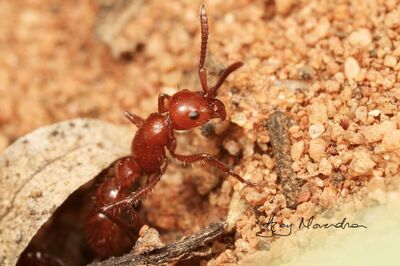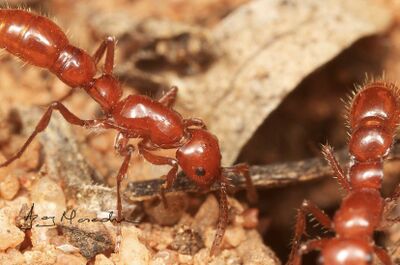Lioponera singularis
| Lioponera singularis | |
|---|---|

| |
| Scientific classification | |
| Kingdom: | Animalia |
| Phylum: | Arthropoda |
| Class: | Insecta |
| Order: | Hymenoptera |
| Family: | Formicidae |
| Subfamily: | Dorylinae |
| Genus: | Lioponera |
| Species: | L. singularis |
| Binomial name | |
| Lioponera singularis Forel, 1900 | |
| Synonyms | |
| |
Photo Gallery
 The specialist ant predator Lioponera singularis raiding an Iridomyrmex bicknelli nest. Iridomyrmex brood is being captured and returned to the Lioponera nest. Scotia Sanctuary, New South Wales, Australia. Photos by Ajay Narendra.
The specialist ant predator Lioponera singularis raiding an Iridomyrmex bicknelli nest. Iridomyrmex brood is being captured and returned to the Lioponera nest. Scotia Sanctuary, New South Wales, Australia. Photos by Ajay Narendra.
Identification
Distribution
Latitudinal Distribution Pattern
Latitudinal Range: -29.81583° to -34.93615°.
| North Temperate |
North Subtropical |
Tropical | South Subtropical |
South Temperate |
- Source: AntMaps
Distribution based on Regional Taxon Lists
Australasian Region: Australia (type locality).
Distribution based on AntMaps
Distribution based on AntWeb specimens
Check data from AntWeb
Countries Occupied
| Number of countries occupied by this species based on AntWiki Regional Taxon Lists. In general, fewer countries occupied indicates a narrower range, while more countries indicates a more widespread species. |

|
Estimated Abundance
| Relative abundance based on number of AntMaps records per species (this species within the purple bar). Fewer records (to the left) indicates a less abundant/encountered species while more records (to the right) indicates more abundant/encountered species. |

|
Biology
Castes
Images from AntWeb
   
| |
| Syntype of Cerapachys singularis rotula. Worker. Specimen code casent0907065. Photographer Will Ericson, uploaded by California Academy of Sciences. | Owned by MHNG, Geneva, Switzerland. |
Nomenclature
The following information is derived from Barry Bolton's Online Catalogue of the Ants of the World.
- singularis. Cerapachys singularis Forel, 1900b: 69 (w.) AUSTRALIA (South Australia).
- Type-material: holotype (?) worker.
- [Note: no indication of number of specimens is given.]
- Type-locality: Australia: “Australie méridionale” (no further data) (Wroughton).
- Type-depository: MHNG.
- Combination in Phyracaces: Emery, 1902c: 24;
- combination in Cerapachys: Brown, 1975: 23;
- combination in Lioponera: Borowiec, M.L. 2016: 164.
- Status as species: Emery, 1911d: 11; Wheeler, W.M. 1918a: 242; Brown, 1975: 23, 65; Taylor & Brown, 1985: 28; Taylor, 1987a: 19; Bolton, 1995b: 144.
- Senior synonym of rotula: Brown, 1975: 23, 65; Taylor & Brown, 1985: 28; Taylor, 1987a: 19; Bolton, 1995b: 144.
- Distribution: Australia.
- rotula. Cerapachys (Phyracaces) singularis subsp. rotula Forel, 1910b: 21 (w.) AUSTRALIA (New South Wales).
- Type-material: syntype workers (number not stated).
- Type-locality: Australia: New South Wales, Inverall, Reedy Creek (Froggatt).
- Type-depositories: ANIC, MHNG, NHMB.
- Combination in Phyracaces: Emery, 1911d: 11.
- Subspecies of singularis: Emery, 1911d: 11; Wheeler, W.M. 1918a: 242.
- Junior synonym of singularis: Brown, 1975: 23, 65; Taylor & Brown, 1985: 28; Taylor, 1987a: 19; Bolton, 1995b: 144.
Type Material
- Cerapachys singularis: Syntype, worker(s), South Australia, Australia, Musee d'Histoire Naturelle Genève.
- Cerapachys singularis rotula: Syntype, worker(s), Reedy Creek, Inverell, New South Wales, Australia, Australian National Insect Collection.
Description
References
- Bolton, B. 1995b. A new general catalogue of the ants of the world. Cambridge, Mass.: Harvard University Press, 504 pp. (page 144, catalogue)
- Borowiec, M.L. 2016. Generic revision of the ant subfamily Dorylinae (Hymenoptera, Formicidae). ZooKeys 608: 1-280 (doi:10.3897/zookeys.608.9427).
- Brown, W. L., Jr. 1975. Contributions toward a reclassification of the Formicidae. V. Ponerinae, tribes Platythyreini, Cerapachyini, Cylindromyrmecini, Acanthostichini, and Aenictogitini. Search Agric. (Ithaca N. Y.) 5(1 1: 1-115 (page 23, Combination in Cerapachys, and senior synonym of rotula)
- Emery, C. 1902c. Note mirmecologiche. Rend. Sess. R. Accad. Sci. Ist. Bologna (n.s.) 6: 22-34 (page 24, Combination in Phyracaces)
- Forel, A. 1900b. Ponerinae et Dorylinae d'Australie récoltés par MM. Turner, Froggatt, Nugent, Chase, Rothney, J.-J. Walker, etc. Ann. Soc. Entomol. Belg. 44: 54-77 (page 69, worker described)
- Forel, A. (1910). Formicides australiens reçus de MM. Froggatt et Rowland Turner. Revue Suisse de Zoologie. 18: 1–94.





